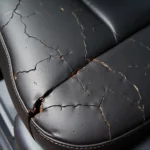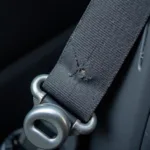Discovering a burn hole in your leather car seat can be disheartening. Whether it’s from a dropped cigarette or a mishap with a hot object, that blemish can feel like a major eyesore. But don’t despair! It might seem daunting, but repairing a burn hole in your leather car seat is often more straightforward than you think.
This comprehensive guide will walk you through the steps to effectively address those unsightly burns and restore your car’s interior to its former glory. We’ll cover everything from assessing the damage to selecting the right repair techniques and products.
Assessing the Damage: How Bad is It?
Before diving into the repair process, it’s crucial to assess the severity of the burn hole. This evaluation will help determine the most suitable repair method and the extent of restoration possible.
- Minor Burns: These are superficial burns that only affect the top layer of the leather’s finish. They often appear as light scorches or discolorations.
- Moderate Burns: These burns penetrate deeper into the leather’s layers, potentially affecting the pigmentation and texture. They might appear as darker marks or even slight depressions in the surface.
- Severe Burns: These are deep burns that have completely penetrated the leather, leaving a hole or significant damage to the underlying material.
Repairing Minor to Moderate Burns
For minor to moderate burns, you can often achieve impressive results with DIY methods using a leather repair kit. These kits are readily available online and at auto parts stores.
Here’s a step-by-step guide:
-
Clean the Area: Begin by cleaning the burned area with a leather cleaner or a mild soap solution. Use a soft-bristled brush to gently remove any dirt or debris. Allow the area to dry thoroughly before proceeding.
-
Sand the Burn: If the burn has created a raised or rough surface, lightly sand the area with fine-grit sandpaper (around 600-grit). Be gentle to avoid further damaging the leather. Wipe away any sanding dust.
-
Apply Leather Filler (if needed): For moderate burns with depressions, apply a small amount of leather filler to the hole using a palette knife. Allow the filler to dry completely, following the manufacturer’s instructions.
-
Match the Leather Color: Select a color compound from your repair kit that closely matches your car seat’s leather. If necessary, mix different colors to achieve a perfect match.
-
Apply the Color Compound: Using a sponge or applicator provided in the kit, apply thin layers of the color compound to the burned area. Let each layer dry completely before applying the next.
-
Apply a Leather Sealer: Once you’re satisfied with the color coverage, apply a leather sealer to protect the repair and restore the leather’s original sheen.
how to repair burn holes in leather car seats
Repairing Severe Burns and Holes
Repairing severe burns that have created holes in your leather car seat generally requires more specialized techniques and materials. While some DIY kits offer patches for larger holes, these repairs can be challenging to blend seamlessly and might not provide the most aesthetically pleasing result.
Professional Repair: For severe burns, seeking professional upholstery repair is often the best course of action. These experts have the experience, tools, and materials to seamlessly repair holes, replace damaged sections of leather, and match the color and texture of your car’s interior.
Leather Seat Covers: As an alternative to professional repair, consider investing in high-quality leather seat covers. These covers can effectively conceal the damage while providing a fresh look to your car’s interior.
black leather car seat repair kit
Preventing Future Burn Holes
Prevention is always better than cure! Here are some tips to help prevent future burn holes in your leather car seats:
-
Be Mindful of Hot Objects: Avoid placing hot objects directly on your leather seats. Use cup holders for beverages and be cautious when handling heated items inside the car.
-
Use Seat Protectors: Consider using seat protectors, especially if you frequently transport children or pets. These protectors act as a barrier, shielding your seats from spills, scratches, and accidental burns.
-
Regular Cleaning and Conditioning: Keeping your leather seats clean and conditioned can prevent the leather from drying out and becoming more susceptible to damage from heat.
“Prevention is key when it comes to maintaining the pristine condition of leather car interiors,” says John Miller, an experienced automotive upholstery specialist. “Simple habits like using coasters and being mindful of hot objects can go a long way in preserving the beauty and longevity of your leather seats.”
[how to repair car seat cover](https://carrepairon.com/how to repair car seat cover/)
Conclusion
While discovering a burn hole in your leather car seat can be frustrating, understanding the nature of the damage and the repair options available empowers you to address the issue effectively. Whether you opt for a DIY repair kit for minor burns or seek professional assistance for severe damage, taking prompt action will help restore your car’s interior and prolong the life of your leather seats.


